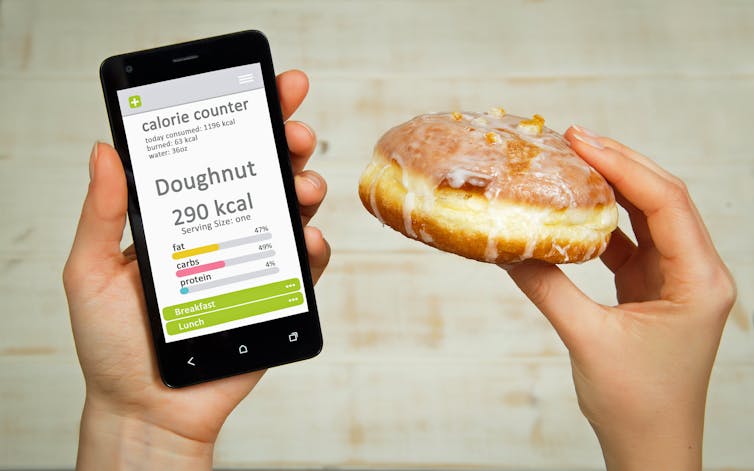You can probably eat more Christmas cookies than you think - just take a look at the calorie guidelines
- Written by Patricia Smith, Professor of Economics, University of Michigan
It’s that time of year when cookies, cakes, candy and treats show up at work, home and every place in between.
As researchers who have investigated obesity[1], people’s body image[2], and fast food[3] and other nutritional topics[4] we often get questions from people concerned about their weight and how they can avoid eating too much.
When we analyze Food and Drug Administration data, however, we find something surprising and possibly heartening: Many people underestimate how many calories nutritionists estimate they should consume each day.
Put another way, we think we’re overeating when in fact we may not be.
Know your caloric benchmark
One of the most important things to know during the often food-centric holidays if you want to avoid gaining weight is how many calories you can consume each day.
On most packages of food you will see a box listing nutritional facts[5]. The majority of these boxes show values for fat, cholesterol, sodium and other nutritional information based on a 2,000-calorie daily diet[6]. Although the label is currently undergoing a redesign[7], the 2,000 daily calorie figure will not change.
Based on these labels, consumers often think that 2,000 calories is the recommended amount they should consume each day. Yet it is wrong for most people.
 Not everyone needs to limit themselves to 2,000 calories.
AP Photo/Larry Crowe[8]
Not everyone needs to limit themselves to 2,000 calories.
AP Photo/Larry Crowe[8]
Caloric breakdown
In fact, the U.S. government releases more accurate guidelines stating how many calories[9] different types of adults should consume.
The government separates adults aged 18 and over into many categories based on age and how active a person is each day.
In general, the younger and more energetic you are, the more calories you can consume. For example, active 18-year-old men need 3,200 calories per day, while women with the same characteristics need only 2,400. Sedentary men in their 50s require 2,200 calories, while sedentary women in the same age group need just 1,600 calories.
At the extreme end, elite athletes like the swimmer Michael Phelps[10] consume up to 12,000 calories during training periods.
In the government’s table[11], some categories cover only a single year, like being 18 years old; some cover a five-year range, like 36 to 40; and others cover many years, like 76 and up. On the whole, however, fewer than 20 percent of the categories have recommendations for exactly 2,000 calories, a standard that appears to have been chosen[12] because it was in the general ballpark for many people and, well, it was easy to use.
If you don’t want to pore over the table to figure how many calories you should consume a day, websites exists with online calculators[13] that will help you pinpoint your personal caloric goal[14].
 Professional athletes like Michael Phelps eat up to 12,000 calories a day while in training.
Reuters/Mike Blake[15]
Professional athletes like Michael Phelps eat up to 12,000 calories a day while in training.
Reuters/Mike Blake[15]
Few people know accurately
One of the more interesting things we noticed while doing our research is that most people don’t know how many calories they can consume without gaining weight.
It is hard to know whether you can eat another holiday treat if you don’t know your daily calorie recommendation. Or, for that matter, how many calories[16] are in that delicious-looking ginger snap – about 28[17] – or slice of apple pie – about 300[18].
The Federal Drug Administration periodically runs nutritional surveys[19] with randomly selected people aged 18 and over in the U.S. The most recent survey was given to more than 1,200 individuals in 2014. In that survey, the FDA asked respondents: “About how many calories do you think a man (or woman) of your age and physical activity needs to consume a day to maintain your current weight?”
Using their answers and their demographic details, it is possible to calculate how close people’s estimates are to the actual levels recommended by the government. Even without knowing how much respondents exercised, the answers were stunning.
Forty percent of respondents thought people like themselves should be consuming fewer than 1,500 calories per day, which is less than lowest caloric recommendation for any age and activity group in the U.S. dietary guidelines. Another 10 percent or so offered a figure higher than 1,500 but still underestimated the correct value for someone of their age and gender who lives a sedentary life.
An additional 5 percent overestimated their recommendation, going even higher than the suggestion for an active person of their age and gender. And 10 percent of respondents said they didn’t know how many calories a person like him or herself should consume. The remaining 35 percent provided a figure that was exactly what the FDA recommended or quite close.
In other words, about two-thirds of respondents didn’t know how many calories they should consume a day – and most of those assumed it’s lower than what it actually is.
That so many adults in the U.S. have mistaken perceptions[20] is important because it is hard to lose or gain weight if you don’t know how much you should eat. People who don’t know their caloric target cannot hit it.
Moreover, the target is likely more generous than many people think. This is at odds with the fact that over two-thirds of all people in the U.S. are either overweight or obese[21]. This means there is a wide gap between the perception of how many calories should be eaten and how many calories people actually are consuming.
 Calorie counters aren’t helpful for people who don’t know how many calories they should be consuming.
Evan Lorne/Shutterstock.com[22]
Calorie counters aren’t helpful for people who don’t know how many calories they should be consuming.
Evan Lorne/Shutterstock.com[22]
Can you eat that cookie?
The next step after learning how many calories can be consumed is to track how many are being eaten each day.
This is just like spending on holiday gifts. The simplest way to avoid overspending[23] is to first set a financial budget and then track spending to ensure you stay on track[24].
So can you eat one or two of those delicious looking holiday cookies? Maybe “yes” today, if you haven’t already consumed too many calories.
References
- ^ obesity (www.jstor.org)
- ^ body image (doi.org)
- ^ fast food (doi.org)
- ^ nutritional topics (doi.org)
- ^ nutritional facts (www.fda.gov)
- ^ 2,000-calorie daily diet (www.nytimes.com)
- ^ undergoing a redesign (www.fda.gov)
- ^ AP Photo/Larry Crowe (www.apimages.com)
- ^ guidelines stating how many calories (health.gov)
- ^ Michael Phelps (www.npr.org)
- ^ government’s table (health.gov)
- ^ appears to have been chosen (www.foodpolitics.com)
- ^ online calculators (www.niddk.nih.gov)
- ^ pinpoint your personal caloric goal (fnic.nal.usda.gov)
- ^ Reuters/Mike Blake (pictures.reuters.com)
- ^ how many calories (doi.org)
- ^ about 28 (www.webmd.com)
- ^ about 300 (www.webmd.com)
- ^ runs nutritional surveys (www.fda.gov)
- ^ perceptions (doi.org)
- ^ two-thirds of all people in the U.S. are either overweight or obese (www.cdc.gov)
- ^ Evan Lorne/Shutterstock.com (www.shutterstock.com)
- ^ overspending (money.usnews.com)
- ^ you stay on track (www.bankrate.com)
Authors: Patricia Smith, Professor of Economics, University of Michigan


